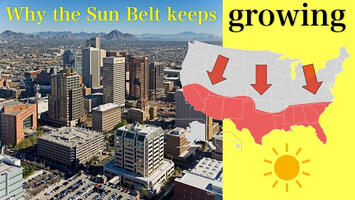
Here’s part 4 in the “Tottering Chicago?” series. Today I’m discussing the third question I raised after reading William Voegeli’s That Tottering Town, a review of the book What Next, Chicago? Notes of a Pissed Off Native Son by Matt Rosenberg. Part 1 is here, Part 2 is here,and Part 3 is here.
Two weeks ago when I wrote Part 1, there were a few poorly-formed questions I included in this paragraph:
“So many questions arise as I look at Rosenberg’s and Voegeli’s problems and solutions. What does the data actually say about what’s going on in Chicago? Is population growth the best single metric to gauge city health? Can a non-Sun Belt city employ a Sun Belt growth model? Do people really believe that today’s successful coastal cities got that way because they employed a Sun Belt growth model? Did New York City emerge from its 70s/80s nadir because it “solved” violent crime and bad schools? Did Sun Belt cities rise post-World War II because of what they did, or what the federal government and global trends did? What really lies ahead for Chicago, or any non-coastal or non-Sun Belt city?”
The questions in bold here are probably more rhetorical than real. I thought it over and came up with a new question that captures the point I was trying to make, and provides a better springboard for a response:
Did today’s successful coastal cities (or any city you define as successful) get that way because of internal/local forces, or external/global forces?
Most cities get to a certain economic position because they’re in the right place at the right time. If you read the histories of American cities, their reasons for existing are in response to various forces. Consider this short American urban history synopsis:
In colonial and post-Revolution America, the cities in the Northeast developed as ports collecting and distributing goods for trade with Europe (New York), havens for persecuted religious groups (Boston), or a little of both (Philadelphia). The first large southern cities, like Richmond, Charleston and Savannah, were local commercial and trade areas for goods, but also developed as trading markets for people in the South’s slave economy. The cities of the Great Lakes and Ohio Valley were defensive outposts established to offer settler’s protection (Pittsburgh, Detroit, Chicago) as well as ports for trade and travel. Western cities were mostly just a twinkle in the nation’s eye, but most were founded by enterprising prospectors or pioneers (Phoenix, Seattle, Denver) or were former Spanish missions (San Francisco, Los Angeles, San Diego).
In the late 19th and early and early 20th centuries American cities made a demographic and economic leap. Northeastern cities built on their commerce and trade history to become the financial centers for a rapidly growing nation. Geographic good fortune gave Midwestern cities a boost; those located on the Great Lakes took advantage of their ports and midcontinent position to become industrial powerhouses; those in inland areas took advantage of fertile land and the expanding national railroad network to become agricultural centers. Generally, Southern cities following the Civil War struggled to keep pace with Northeastern and Midwestern cities. Meanwhile Western cities were rapidly coming into their own.
Then we get to the parts of American urban history that are more familiar to us. Fortunes shifted following World War II for Southern and Western cities, as the regions began to merge to become the modern Sun Belt. Midcentury technological advances – the Interstate highway system, expanded affordable air travel – brought American cities closer together than ever before. Sun Belt cities were poised to market climate, solid business climates with little to no union interference, and affordability as their selling points.
Even more recently, coastal cities were in the right place during the late 20th and early 21st centuries. The East and West coasts had long been favored with elite educational institutions. They’ve been able to capitalize on a global economic system that prized highly educated workforces and the economic sectors that employed them (tech, finance, media, etc.) moved to center stage.
In each case, external forces, whether regional, national or global, boosted their growth. In fact, some cities were able to use the gains made during one economic cycle to serve as the springboard supporting the next external wave. Commerce and trade in 1700s New York City built the economic infrastructure for it to become the global financial center that it is. Having Harvard and MIT in Boston and Stanford and UC Berkeley in the San Francisco Bay Area have given both the intellectual heft needed to be successful in an era that rewards it. Seattle was fortunate enough to have a native son relocate his technology company in his hometown, have a non-native establish another technology company there, and have them both become tech powerhouses. Washington, DC became a global city because America became a global power, not the other way around. Cities catch waves, they don’t create them.
Read the rest of this piece at Corner Side Yard Blog
Pete Saunders is a writer and researcher whose work focuses on urbanism and public policy. Pete has been the editor/publisher of the Corner Side Yard, an urbanist blog, since 2012. Pete is also an urban affairs contributor to Forbes Magazine's online platform. Pete's writings have been published widely in traditional and internet media outlets, including the feature article in the December 2018 issue of Planning Magazine. Pete has more than twenty years' experience in planning, economic development, and community development, with stops in the public, private and non-profit sectors. He lives in Chicago.
Photo source: youtube.com












